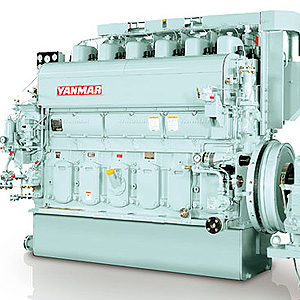Yanmar Emergency Use Generators
Blog | July 28th, 2017 
A hospital switches over to its standby generator so that critical care services can continue. Over at an airport, the runway lights remain on so that they can guide an aircraft home. It’s diesel fueled equipment that provides this backup electricity, but it is Yanmar emergency use generators that reinforce those machines with a much-needed reliability factor.
What are Emergency Generators?
All while the power feeds into a generator-backed building, a sensor circuit is monitoring the current. If that current drops out, an emergency generator is activated. A diesel-powered engine coughs, it ratchets, and it spins smoothly into action. That highly reliable engine, a Yanmar machine, is coupled to a power generator. A brushless rotor turns, then an electromagnetic field is induced in a stator. Essentially, the kinetic energy produced by the diesel powerplant is converted into electromagnetic force, and that magnetic flux becomes electricity. Tasked with supplying mains power to an entire building or just enough electricity to keep certain chosen services functioning, the backup power switches over within seconds of the initial power failure.
Designing Emergency Circuits
When Yanmar emergency use generators are installed, the cables leaving their distribution boards are expected to power a select group of emergency circuits. One example of this intelligent electrical routing method would be the lights required to evacuate a building after some seismic disaster occurred. A second example would be the emergency circuits prioritizing the power needs of an operating theatre in a hospital. For our third prioritization application, well that would be the emergency power keeping airport taxi track lights and landing lights live. A quick evaluation of these essential services suggests one feature above all else. That feature is the reliability factor covered in our opening paragraph. Power provisioning, current and voltage smoothness, and transitory loading compensation mechanisms, probably in the form of an electronic governor, are all important generator functions here, but that element of absolute reliability really outweigh everything else.
A backup generator is a two-stage machine. In Yanmar emergency use generators, that two-stage configuration receives uniform attention. The engine, the diesel fueled stage, is built to start quickly and remain in action during the entire power failure event. Essentially, the drive governing assembly sips fuel, keeps the output torque regulated, and therefore assures an even electrical power output. As for the electrical stage, the stator windings and brushless rotor are manufactured from the finest materials, from cables and connections that are designed to readily integrate with a building’s power distribution systems, as regulated by local mains electricity guidelines.
Optimized by NetwizardSEO.com.au
Recent Posts
- Yanmar Diesel Generators: Planned vs Predictive Maintenance Strategies for Remote Operations
- Mareflex SOLAS Marine Tapes: Safety Applications on Marine Vessels
- Yanmar Propulsion Systems: FPP vs CPP Propellers for 6EY and 6N Series Fuel Efficiency
- Mitsubishi K.K. Purifier Separator: The Key to Cleaner Fuel and Smoother Operations
- Kemel Air Seal Retrofits: Leak-Free Stern Tube Seals and Reduced Lube-Oil Risk
- Yanmar Auxiliary Generators: Sizing for Reefers, Hotel Loads, and Dynamic Positioning Systems
- Water Lubricated Stern Tube Bearing (EVR): Proven Technology for Smooth and Quiet Operations
- Marine Spare Parts Australia: Genuine Components for All Vessel Types
- Yanmar Diesel Generators – Powering Remote and Off-Grid Operations
- Authorised YANMAR Parts Supplier in Australia – Genuine Components Guaranteed
